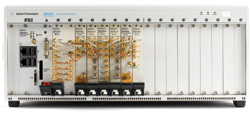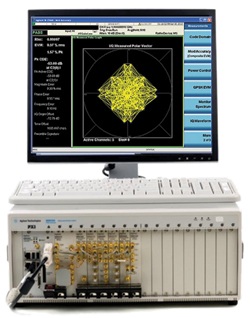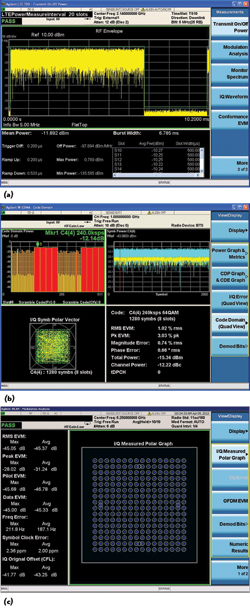
For those who develop wireless devices, the following refrain will be familiar: “I have to test twice as much in half the time, we’re selling the product for half its previous price, and volume keeps growing.” As devices become increasingly dense with integrated capabilities, testing “twice as much” includes not just “more things” but also “new things.”
Satisfying this “twice/half” dynamic requires three essential attributes in the test solution: speed, continuity and longevity. Speed is needed in two dimensions: shorter development time and faster test times. Continuity comes from consistent test results across R&D, design verification (DV) and manufacturing: apples-to-apples comparisons of measurement results reduce uncertainty, delays and finger-pointing. Longevity refers to flexible capabilities in signal analysis and signal generation that enable system creators to handle expanding test requirements.

Figure 1 Agilent PXI VSA/G configured with optional keyboard, monitor, embedded controller and software.
In the evolution of RF test solutions, a new and logical step forward is the Agilent M9391A and M9381A PXI vector signal analyzer and generator (PXI VSA/G). For the testing of power amplifiers, front end modules and more, the PXI VSA/G offers fast, proven results through the combined benefits of raw hardware speed and standard-specific measurement applications. In addition, compatibility with Agilent 89600 VSA software enables deeper analysis and support for Agilent SystemVue electronic system-level (ESL) software provides links between design, simulation and measurements.
Combining Vector Signal Analysis and Generation
With today’s complex modulation schemes, magnitude-only spectrum analysis lacks the phase information needed to demodulate and characterize standardized wireless signals such as LTE or 802.11ac. In contrast, vector signal analysis captures magnitude and phase information, demodulates the signal according to the relevant standard, and provides essential figures of merit such as error vector magnitude (EVM).
Similarly, analog signal generators are not able to simulate today’s most advanced wireless signals—and the solution is a vector signal generator. These are equipped with the memory, signal processing and digital-to-analog conversion technologies needed to realistically simulate highly complex signals.
These signal-analysis and signal-generation capabilities are available in benchtop and modular form factors. When space and cost are at a premium, a modular solution such as the PXI VSA/G makes both capabilities available in a single PXI chassis (see Figure 1). To enable closed-loop testing of power amplifier (PA) parameters such as gain compression, the PXI VSA/G provides internal connections between the analyzer and the generator. This combination of speed, capability and convenience is emerging as a highly effective way to address the “twice/half” dynamic in DV and manufacturing applications.
Meeting Technical Requirements
To help accelerate system development and device testing, two key themes apply to the PXI VSA/G: raw hardware speed and RF parametric performance. On the production line, measurement throughput is a key metric. To help reduce test time, the PXI VSA/G provides extremely fast signal-analysis results enabled by a unique hardware mode dedicated to power measurements. This utilizes real-time hardware resampling, which enables high speed modulation analysis by reducing the amount of data sent across the bus and thereby accelerating measurement speed.

Figure 2 Example screens from Agilent modular X-Series applications: LTE-TDD (a), W-CDMA (b) and 802.11ac (c).
Measurement time can also be reduced with rapid switching of both frequency and amplitude, which comes from the innovative “fastune” baseband-adjustment capability built into the PXI VSG. In addition, the need for external hardware is reduced through capabilities such as the +19 dBm maximum power output of the PXI VSG.
When working together, the preceding capabilities can reduce test times by enabling power servos to converge faster while providing excellent linearity, repeatability and absolute amplitude accuracy. This is supported by a built-in RF calibration signal that covers the PXI VSA/G’s entire frequency range of 3 GHz (standard) or 6 GHz (optional).
Addressing business requirements
To help ease business pressure, three more themes apply to the PXI VSA/G: faster development, longevity in capability and total cost of ownership. The PXI VSA/G helps reduce development time with Agilent’s X-Series applications for modular instruments, which are derived from those used with Agilent X-Series signal analyzers. Using the same algorithms across R&D, DV and manufacturing ensure continuity, which minimizes time spent reconciling inconsistent results. Currently, the available applications include those that support W-CDMA/HSPA/HSPA+, LTE FDD, LTE TDD, GSM/EDGE/EDGE Evo, TD-SCDMA/HSPA, 1xEV-DO, cdma2000 and 802.11 (a, b, g, n and ac) wireless LAN (see Figure 2).
To reduce the time spent on signal creation, the PXI VSG is compatible with Agilent Signal Studio software. Its flexible suite of signal-creation tools provides standard-compliant, performance-optimized reference signals that enhance the process of characterizing and validating wireless devices. Fully defined signals—with or without impairments—can be downloaded and stored in module memory for rapid recall and playback.
With regard to longevity, optional and built-in capabilities allow the PXI VSA/G to evolve as requirements change. For example, the standard 40 MHz analysis bandwidth is upgradeable to 160 MHz analysis bandwidth (optional) through a software license key.
Finally, a variety of factors affect the total cost of ownership (TCO) for any solution. In the PXI VSA/G, the “whole product” envelope address TCO with a standard three-year warranty, one day of solution optimization with an Agilent application engineer and a built-in “calibration status manager” application. To help reduce TCO for global organizations, Agilent has 50 service and support centers located around the world.
Looking to the Future
Ongoing industry trends suggest that RF requirements will keep growing while timelines keep shrinking. To help ease the pressure—technical and business—a test solution should provide speed in development, speed in measurements, continuity in measurements and longevity in capability. With raw hardware speed and standard-specific measurement applications, the Agilent PXI VSA/G is designed to meet these needs. Through its fully modular hardware, links to analysis and simulation software, and the ability to leverage proven measurement applications, the PXI VSA/G is a low-risk way to manage change and be ready today for what may come tomorrow.
Agilent Technologies,
Santa Clara, CA,
www.agilent.com/find/M9391A
